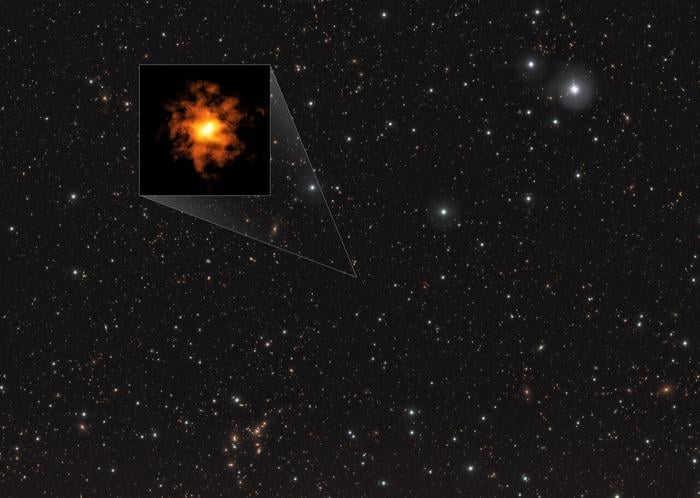A team of astronomers has discovered REBELS-25, the most distant Milky Way-like galaxy ever observed, challenging our understanding of early universe formation.
Summary: Researchers have found a surprisingly well-structured galaxy from when the universe was only 700 million years old, contradicting current theories about early galaxy formation and evolution.
Estimated reading time: 5 minutes
In a surprising twist that’s shaking up our understanding of the early universe, astronomers have discovered a galaxy that shouldn’t exist—at least not according to our current theories. REBELS-25, as it’s been dubbed, is a disc galaxy with an orderly structure similar to our own Milky Way. The catch? We’re seeing it as it was when the universe was a mere infant, just 700 million years old.
This discovery, made using the Atacama Large Millimeter/submillimeter Array (ALMA), is forcing scientists to reconsider how quickly galaxies can evolve into the structured formations we see today.
A Cosmic Puzzle
The early universe was a chaotic place. Most galaxies from this era appear messy and irregular, slowly merging and evolving over billions of years into the more organized structures we observe in the present day. At least, that’s what our theories have long suggested.
“According to our understanding of galaxy formation, we expect most early galaxies to be small and messy looking,” explains Jacqueline Hodge, an astronomer at Leiden University and co-author of the study.
But REBELS-25 is bucking this trend. Its well-defined, rotating disc structure is reminiscent of much more mature galaxies, despite existing at a time when the universe had barely begun to take shape.
Breaking Records and Challenging Theories
The light we’re receiving from REBELS-25 was emitted when the universe was only 5% of its current age. This makes it the most distant strongly rotating disc galaxy ever discovered, a title that comes with some significant implications.
Lucie Rowland, a doctoral student at Leiden University and the study’s lead author, emphasizes the gravity of this finding: “Seeing a galaxy with such similarities to our own Milky Way, that is strongly rotation-dominated, challenges our understanding of how quickly galaxies in the early Universe evolve into the orderly galaxies of today’s cosmos.”
The Power of ALMA
REBELS-25 was initially spotted in previous ALMA observations, but those data weren’t detailed enough to confirm its nature. The research team conducted follow-up observations using ALMA’s high-resolution capabilities to get a clearer picture.
“ALMA is the only telescope in existence with the sensitivity and resolution to achieve this,” notes Renske Smit, a researcher at Liverpool John Moores University and co-author of the study.
These new observations not only confirmed REBELS-25’s rotating structure but also hinted at even more advanced features. The galaxy appears to have a central elongated bar and possibly even spiral arms, though further observations will be needed to confirm these tantalizing details.
Implications for Our Understanding of the Universe
The discovery of REBELS-25 could potentially transform our understanding of early galaxy formation and the evolution of the universe as a whole. If more galaxies like REBELS-25 are found, it might indicate that the processes of galaxy formation and maturation can occur much more rapidly than previously thought.
This finding opens up new avenues for research and raises intriguing questions about the conditions in the early universe that could have allowed for such rapid galactic development. It also highlights the importance of continued deep-space observations using advanced instruments like ALMA.
As we peer further back in time and space, we’re likely to encounter more surprises that challenge our assumptions about the universe’s history. REBELS-25 serves as a reminder that the cosmos is often more complex and mysterious than we imagine, continually pushing the boundaries of our scientific understanding.
Quiz
- How old was the universe when the light from REBELS-25 was emitted?
- What makes REBELS-25 unique compared to other early galaxies?
- Which instrument was crucial in observing and confirming the nature of REBELS-25?
Answer Key:
- 700 million years old
- Its well-defined, rotating disc structure similar to mature galaxies
- The Atacama Large Millimeter/submillimeter Array (ALMA)
Further Reading
- [Research paper on REBELS-25](Link not provided in the press release)
- More information about ALMA
- European Southern Observatory (ESO) website
Glossary of Terms
- Disc galaxy: A galaxy characterized by a flattened, rotating structure, often containing spiral arms.
- ALMA: Atacama Large Millimeter/submillimeter Array, a powerful radio telescope located in Chile’s Atacama Desert.
- Redshift: A measure of how much the light from a cosmic object has been stretched as it travels to Earth, used to determine distance and age in astronomy.
- Early Universe: The period shortly after the Big Bang when the first stars and galaxies were forming.
- Galaxy formation: The process by which galaxies are created and evolve over cosmic time.
- Rotation-dominated: Referring to a galaxy whose structure and motion are primarily determined by its rotation rather than random motions of stars and gas.
Enjoy this story? Get our newsletter! https://scienceblog.substack.com/
If our reporting has informed or inspired you, please consider making a donation. Every contribution, no matter the size, empowers us to continue delivering accurate, engaging, and trustworthy science and medical news. Independent journalism requires time, effort, and resources—your support ensures we can keep uncovering the stories that matter most to you.
Join us in making knowledge accessible and impactful. Thank you for standing with us!

